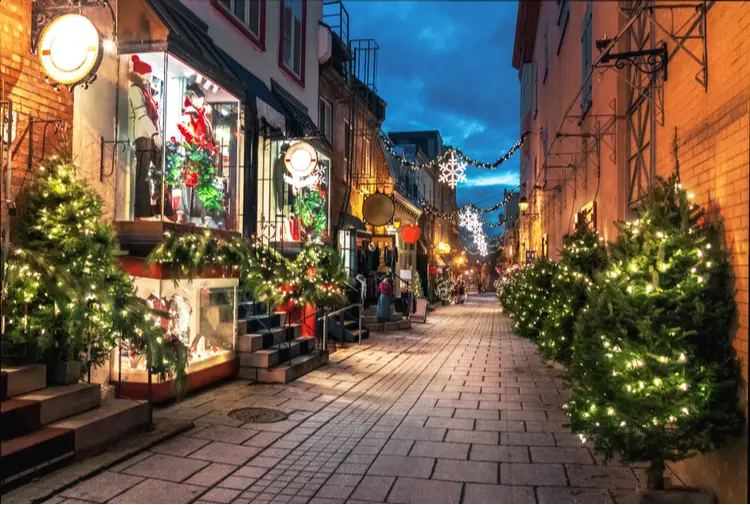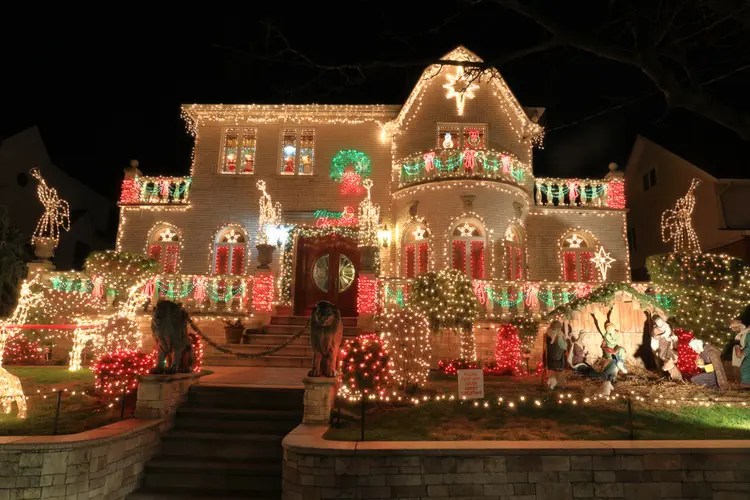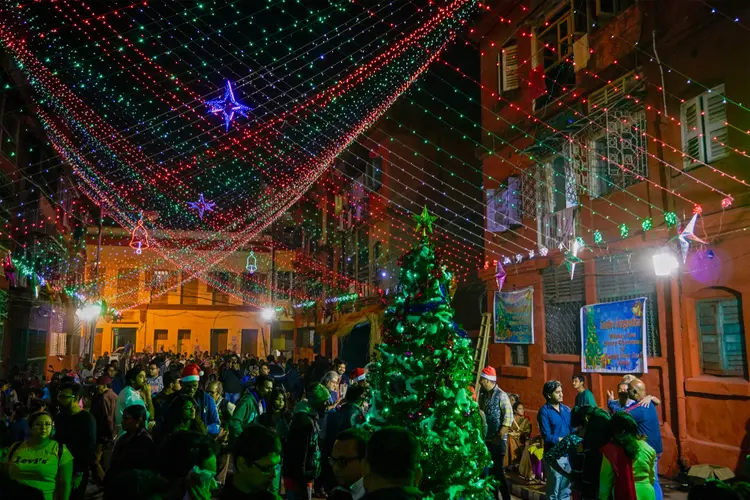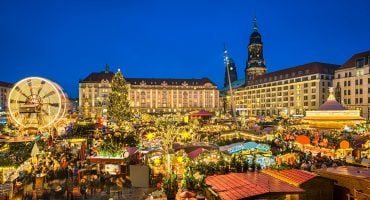The world is full of stunning Christmas traditions, weird Christmas fun facts and delicious recipes. The season’s celebrations are as varied and unexpected as the cultures themselves, from the cagatió in Catalonia, Spain to decorating boats for Christmas in Greece. Let’s travel the world together to discover them, from Portugal to the Philippines!
The Santa Parade in Toronto, Canada

The first Christmas tradition on our list is from one of the most beautiful destinations for a snowy Christmas: Canada! And let’s be clear, Canadians don’t joke around when talking about Christmas. Did you know Toronto hosts the oldest and largest Santa Parade in the world?
There are also many traditional recipes throughout the country. In Quebec, one of the meals served on Christmas Eve is the French Canadian Christmas Pie (also called tourtiere).
The Nativity scene in Naples, Italy

Christmas in Italy is magical as it’s one of the most celebrated festivities in the country. In addition to the Christmas tree, it is common to set up the nativity scene, invented in Italy in the Middle Ages. In fact, the city of Naples is famous all over the world for its precious Nativity scene, called Presepe Napoletano.
As you very well know, food in Italy is crucial to any celebration. Every region has its own Christmas dish and every family has its own tradition. Certainly, there are two desserts that cannot be missing from the table: the panettone and the pandoro. The first comes from Milan and the second from Verona, but they are loved all over Italy. Give them a try next time you go to Italy in the winter!
In Italy, children don’t just believe in Santa Claus, but also in Befana. She is a very old woman, flying on a broomstick, who visits children on the night between the 5th and 6th of January. She brings candy to good children and charcoal to bad ones, putting it in a sock that has to be hung the night before.
Barbecue for Christmas in Australia

Have you ever wondered what the Christmas season looks like down under? Coinciding with the beginning of summer, Christmas in Australia is synonymous with sun, barbecues and long days spent at the beach.
As a matter of fact, many Australians have a cold Christmas dinner or barbecue with seafood on the 25th of December. It is therefore pretty usual to see fish markets overcrowded on Christmas morning. On the following day, also known as Boxing Day, locals gather with friends and head to the beach to enjoy another delicious barbecue under the sun!
Fun fact: the lyrics of the Christmas carols are sometimes modified to replace the mentions of snow and the cold winter with Australian turns of phrase!
Home protector Nisse in Norway

Meet Nisse! A mythological creature from Scandinavian folklore similar to a gnome. According to tradition, it protects the house and the family. That is why Norwegians leave an oatmeal bowl for him under the tree on Christmas Eve. If Nisse does not get his porridge, it will get naughty and break things in the house!
Another particular Norwegian tradition is the celebration of Lille Julaften (Little Christmas Eve) on the 23rd of December. During that night, everyone stays at home with the kids and makes a sweet gingerbread house together, which will be eaten at the end of the Christmas season.
Christmas Eve is the biggest family gathering in Norway. The most common dinner is a dish of pork ribs called ribbe, but the boiled cod, the lamb ribs and the ham roast are also popular meals for that night. Along with the delicious food, they drink juleøl, meaning ‘Christmas beer’. Cheers!
Celebrating Sinterklaas in The Netherlands

In the Netherlands, the 5th of December is the most important day of the festive season for kids: indeed, Sinterklaas (St. Nicholas) brings them their presents! Children usually leave a shoe out by the fireplace or a windowsill, previously filled with carrots for Sinterklaas’s horse.
According to the tradition, Sinterklaas lives in Spain, and every year he chooses a different harbour to arrive in The Netherlands. Parties are often held on the 5th of December: children play treasure hunt games and follow clues in order to find presents. On that occasion, they also enjoy special biscuits and sweets: the pepernoot, flavoured with cinnamon and spices, and the banketletter, often in the shape of an ‘S’ for Sinterklaas.
Talking about food, the traditional way to eat with family and friends on Christmas days is called gourmetten. All guests get tiny raclette pans and prepare their own meal (meat, vegetables…) at the center of the table!
The Advent wreath in Germany

In Germany, the 6th of December is the second most important day of the Christmas season right after Christmas Eve – at least for children. On the previous evening, they put their polished shoes outside the front door and overnight Nikolaus (St. Nicholas) filled them with sweets, fruits and small presents. The main presents will be gifted on Christmas eve though – officially brought from the Weihnachtsmann (Santa Claus).
Another very common tradition in Germany is the Advent wreath – you’ll find one in almost every house. It has four candles, and every Sunday in Advent a new candle is lit. Then finally on Christmas eve, the Christmas tree is brought to the house.
Of course, Germany is world-famous for its Christmas markets, which take place in every city, large or small. At the Christmas markets you can enjoy mulled wine and all the delicious food that’s typical during the Christmas season in Germany: Stollen, Gingerbread and many other delicacies.
Cagatió in Catalonia, Spain

Did you know that Catalonia, an autonomous region inside Spain, has its own singular Christmas traditions? Discover the most famous ones!
Have you ever heard about the cagatió? Families “feed” this wooden log during December and, when Christmas Day arrives, it is time to make the log poop! Covered with a blanket, the children beat it with sticks while singing a traditional song. Once finished, the kids lift the blanket and… surprise! The log has pooped many presents for them!
When admiring a pessebre, the nativity scene in Catalonia, have a closer look. You will find a very peculiar figurine among the traditional ones. This is the caganer, which appears in the act of defecation, its name literally means ‘the pooper’! You can buy your own in some of the Christmas markets and stalls in the main cities of the region.
And when it comes to food, Catalonia also has its own traditions. The Christmas star dish is the escudella, which includes soup broth as a starter and all the meat cooked in the broth, served afterward. Delicious!
Jézuska, baby Jesus, brings the presents in Hungary

Did you know that Hungarians traditionally don’t put a Christmas tree in their house before Christmas Eve? And sometimes only the adults decorate the tree, so when children get home and discover it, they are told that nice angels brought the tree for them!
Like many countries in Eastern Europe, Hungary celebrates St Nicholas (called Mikulás) on the 6th of December. Then Télapó (Old Man Winter – the equivalent of Santa) comes to the scene. But on the big day, it’s not him who sneaks in and gives out gifts, it’s little Jézuska, baby Jesus!
What would you find on Hungarian tables for Christmas? The most typical dish is halaszlé, a fish soup spiced with paprika paste or powder. For dessert, everyone loves a slice of beigli – a special kind of poppy seeds roll. Yummy!
In the Philippines, Christmas starts in September

When does the Christmas season begin? Some may say on the 1st of December, some maybe would say after Halloween, well in the Philippines it starts… on the 1st of September! From that day on, you can hear Christmas songs in shops and on the radio. Filipinos love to celebrate and use this time to get together with families and friends to share good food.
One of their Christmas traditions is to hang parols, a star-shaped lantern made of bamboo and coloured paper in the streets. This star represents the star that guided the Wise Men.
During the Christmas season, in the Philippines you usually get a rice cake for breakfast: the Bibingka. Traditionally, it is baked in a clay pot on charcoal for hours. Of course, if you wish to taste it at home, you can try to bake one in your oven!
Besides the Philippines, here’s some more inspiration on other hot and sunny places to visit in December.
Growing Christmas wheat in Croatia

Any clue about how they celebrate Christmas in Croatia?
One of the most original Christmas traditions starts on Saint Lucy’s Day on the 13th of December. Each family grows wheat onto little pots or plates, taking care of it until the 24th of December. On Christmas Eve, the plant, called ‘Christmas wheat’, is put underneath the tree. The tradition says the taller the wheat grows, the more prosperous the year will be.
During this period of the year Croatians enjoy fritule, small doughnut balls flavored with rum and lemon and topped with powdered sugar or chocolate. The protagonists during Christmas meals are sarme, cabbage rolls filled with rice and meat, and different types of pork sausages.
However, the most important ritual of Christmas celebrations in Croatia is to light a log on Christmas Eve, that ideally will burn until Christmas Day. Croatians have local variations for this tradition, such as drizzling the log with wine before burning it. The Christmas season ends on the 6th of January, on Epiphany Day, the moment to take down the trees and decorations.
Non-Christian Christmas in Japan

In recent years, Christmas has also become a tradition in Japan, the land of the rising sun. During the Christmas season, wonderful lights shine through the streets of major Japanese cities.
Christmas is not a religious holiday in Japan, but a way to get together, exchange gifts and eat kurisumasu keki (Christmas cake), as well as fried chicken from fast-food chains!
A peculiar characteristic of Japan is that tradition is always mixed with innovation in an almost perfect balance. This can also be seen in the small things, such as the way gifts are wrapped. In fact, very often gifts are wrapped in furoshiki, a traditional Japanese wrapping cloth. The fabrics exist in a large variety of colours and patterns, and above all, it’s eco friendly!
Grandiose Christmas decorations in New York

Christmas season is a very special time of the year on the other side of the Atlantic! Singing Christmas carols, drinking eggnog or decorating houses are some of the favorite activities of many Americans throughout the month of December.
And of all American cities, New York may be the one that embodies the most this Christmas spirit with iconic traditions such as the Christmas tree of the Rockefeller Center, Christmas shows on Broadway, the Wollman skating rink at Central Park or the magical Christmas lights in Dyker Heights.
Starting the weekend after Thanksgiving and through New Year’s Eve, this neighborhood of Brooklyn hosts some of the most spectacular Christmas decorations of the country. Every day from 5 pm to 9 pm, locals and tourists take a walk around the streets to discover the facades adorned with giant Santas, nutcrackers and tinsels!
Saint Lucy’s Day in Sweden

Happy Saint Lucy’s – or Saint Lucia’s – day! If the 13th of December is a day like any other in many countries, in Sweden it marks the beginning of the Christmas season and is considered a symbol of hope and light during the darkest time of the year.
On that day, each town and city in the country chooses its Saint Lucia who will guide a procession made up of young girls and boys, all dressed with white gowns and handling candle lights. If you have the chance to celebrate Christmas in Sweden, you will probably meet a peculiar ornament: the Yule goat, usually made with straw and bound with red ribbons. Giant versions are frequently erected in towns and cities!
A popular food served on that day are Lussekatts, delicious buns flavored with saffron, and glögg, the traditional Swedish mulled wine! Yummy, right?
Young Men’s Festival for Christmas in Portugal

One of the local traditions in Portugal is the “Christmas bonfire” made of fir tree trunks. It is lit before the beginning of the Christmas Eve Mass (called the “rooster mass” because the legend says that the rooster sang a bit after the birth of baby Jesus). The longer the bonfire will last, the more luck you will have!
Another Christmas tradition takes place in the north of Portugal: it is called Festa dos Rapazes, the Young Men’s Festival. During this celebration, groups of boys who must be single and over 16 years old go from house to house, between Christmas and Epiphany, wearing beautiful masks, asking for donations or food, and playing music. Each boy can participate in the event only once in his life, after which he is considered a man.
When it comes to food, turkey is often the main dish. For dessert, there’s no Christmas in Portugal without the famous Bolo Rei, a donut-shaped cake filled with citrus fruits, candied fruit and pine nuts. Traditionally, a small gift and a broad bean are both hidden in the cake. If you find the bean in your slice of cake, you will have to pay for the Bolo Rei next year! Another typical dish, which is also famous in Brazil, is the Rabanada, a kind of French toast: bread dipped in egg and milk and then fried. Delicious!
12-course meal for Christmas Eve in Poland

Did you know that Polish don’t sing Christmas carols before the 24th of December? Indeed, people start singing koledy, only when the Christmas vigil mass, named Pasterka, has finished. The most popular Christmas carol in Poland is ‘God is Born’.
As most of the people in Poland are catholic, Christmas is the biggest festivity of the year! During the Advent period, the Polish bake piernik, the typical yummy gingerbread that is prepared in different shapes as cookies or cakes.
On Christmas Eve, called Wigilia in Polish, families decorate a tree and share a dinner made up of 12 different dishes – representing the 12 apostles. The star dish is always the carp, which is meant to bring good fortune. The other protagonist of this holy night is barszcz pierogi, Polish dumplings cooked in beet soup.
A German Christmas tradition imported into the UK

Did you know that Christmas trees were popularised in the UK by the husband of Queen Victoria? Prince Albert was German, so he thought that it would be nice to import one of his country’s traditions in England. Now Christmas trees are as popular as hanging up stockings by the fireplace! If you’re spending Christmas in London, these are the spots you cannot miss!
In the UK and some Commonwealth countries, presents are not only given on the 25th but also on the 26th, for what is called “Boxing Day”. Nothing to do with the sport of boxing though. The name comes from a time when the rich used to box up gifts to give to their servants and the poor.
Regarding food, the typical English Christmas menu usually includes roast turkey and vegetables (including brussels sprouts, not everyone’s favourite!) served with cranberry sauce. For dessert, you’ll have the choice between Christmas pudding, mince pies, and trifle. Better love dried fruits, cinnamon and custard! The table is also full of Christmas crackers, an entertainment for the whole family.
Summertime Christmas in South Africa

Although Christmas is celebrated in the middle of summer in South Africa, people still love to decorate their homes and cities. You can find Christmas trees everywhere, and children leave a stocking out on Christmas Eve for Santa Claus – also known as Sinterklaas and Kersvader for those who speak Afrikaans, a language based on Dutch.
During the school Christmas holidays, many people take trips to the spectacular countryside of South Africa. Such a trip may include seeing wild animals at the famous Kruger National Park or visiting the beautiful Garden Route. Or you can climb up to 3,000+ meters and go skiing in Lesotho, one of the most unique places for a ski holiday.
Besides the typical Christmas dishes that are popular around the world like turkey, duck and other roasted meat, there’s a very special meal that you can find only in South Africa: the sweet Malva Pudding. It’s a traditional Christmas dessert which includes apricot jam and is served hot with custard and ice cream.
13 desserts for Christmas in Provence, France

In France, one region in particular represents the Christmas spirit the best: Alsace. Usually, each year millions of tourists admire the giant Christmas Tree in Strasbourg after buying some bredele (traditional Christmas butter biscuits), and a glass of hot wine at the Christmas market.
Another region that stands out for having its own Christmas tradition is Provence, in the southeast of France. In Provence, you can taste no less than 13 desserts during the Christmas season. They typically include nuts, dried fruits, olive oil bread, nougat… It can vary and each family has its favourite, but they have to be 13!
Nevertheless, at country level, it is overall acknowledged that the official national seasonal dessert should be the bûche de Noël (the Yule log). It’s basically a sponge cake covered with cream which can come in many flavours. France’s most famous pastry chefs always rival creativity to create innovative mouthwatering new versions every year.
In case you had a doubt, food is a serious topic in France during the Christmas season… just like the rest of the year!
A mango tree for a Christmas tree in India

In India, Christmas is mainly celebrated in the city of Mumbai and the state of Goa as well as in some areas in the east of the country.
While in many places the traditional Christmas tree is a pine tree, in India people decorate mango or banana trees instead, sometimes also using the leaves to decorate their homes! Streets are also adorned with garlands of giant paper lanterns in the shape of stars creating a truly magical atmosphere.
The typical Christmas cake in India? A plum cake! Indians have a thing for sweets during the season and at this time of the year, tables are usually filled with kulkuls (deep-fried sweet twirls), neureos (small pastries stuffed with dry fruit and coconut) and dodol (a sort of toffee with coconut and cashew).
Visit the Santa Claus Village in Finland

Are you curious about where Santa Claus might live? One of the hypotheses is Finland.
In Rovaniemi, Lapland, you can visit the Santa Claus Village, where the landscape is covered with snow for about half of the year! It is a magical place where it is possible to live surrounded by reindeer and elves. It’s also a fantastic place to admire the Northern Lights, a once-in-a-lifetime experience. Like various other places in Finland, Rovaniemi also holds a beautiful Christmas market.
On Christmas Eve, the local tradition is to decorate the Christmas tree and enjoy a relaxing sauna. Then, families usually visit the grave of deceased relatives and leave a lit candle on top of it as a sign of remembrance.
Finnish seasonal delights include the Joulutorttu, a typical cake filled with plum jam, and a special rice pudding that can be found in various Scandinavian countries. An almond is slipped inside and will bring good luck to the person who finds it!
The 9 posadas in Mexico

Navidad, as it is called in Spanish, is a very important time of year in Mexico. The 16th of December marks the beginning of the festivities as on this day the very first of the nine Posadas is held: a tradition where Mexican people gather each of the nine nights leading up to Christmas in a different house asking for shelter. In fact, Posadas means lodging in Spanish! On the agenda? Food, Christmas carols and piñatas!
During the month of December, the streets of cities and towns are decorated with fantastic Christmas lights (sometimes shaped as piñatas as well!) and the traditional poinsettia flowers. Celebrations usually last until the 6th of January, on the Día de los Reyes, which is the occasion to savour a piece of rosca de Reyes, the traditional cake, and taste a glass of ponche navideño, the traditional Mexican fruit punch!
The origins of Silent Night are in Austria

Did you know that Austria is the home of the most popular Christmas carol in the world, Stille Nacht (Silent Night)? It was written and performed for the first time in Austria in 1818! It is sung on Christmas Eve, when Austrians also bring the Christmas tree into the house, decorate it, and savour their main Christmas meal.
The traditional Christmas dishes in Austria are either fried carp or roasted goose, served with braised red cabbage and dumplings. Typical Austrian Christmas cookies are Lebkuchen (gingerbread) and Vanillekipferl (vanilla almond cookies).
In Austria, children believe that Christkind, a golden-haired, angelic childlike appearance, decorates the Christmas tree and places the presents under it. And for that reason, the Christmas markets in Austria are named Christkindlmarkt. You can usually find them in most cities – but not in 2020, sadly.
Delicious unique recipes for Christmas in Denmark

In Denmark, Christmas is called Jul and the most important festive day is on the 24th of December. On this day, Julemanden (Santa Claus), accompanied by a group of Nisse (elves), brings the presents, and people celebrate with a sumptuous Christmas dinner in the evening. It is also quite common in Denmark to dance around the Christmas tree, which is decorated with real candles for the right hygge feeling.
During the Advent season, the Danish enjoy a lot of delicious food and drinks such as Æbleskiver, a sort of small fried doughnuts sprinkled with icing sugar and Hvid Gløgg, a Danish white version of mulled wine.
On Christmas Eve, roast pork or duck is served with red cabbage, boiled potatoes and gravy. After that, the Danish eat their very unique and delicious Christmas dessert: Risalamande. It’s a rice pudding topped with cherry sauce where a whole almond will be hidden. The family member who finds the almond in their bowl gets a prize or an extra present.
Decorating boats for Christmas in Greece

In Greece, the locals don’t just decorate Christmas trees, but also Christmas boats! Why boats? Greece is a country of sailors, and historically men were often gone for several weeks during winter. When they returned home, small boats were decorated inside the houses to honour their courage. Nowadays, larger boats are also illuminated in the harbours of cities and villages.
Each year at Christmas, a debate about desserts divides the families: melomakarona or kourabiedes? How come these two sweets generate so much passion? Well, to determine which one is the tastiest, the best thing is probably to cook both of them and gladly debate around the table!



